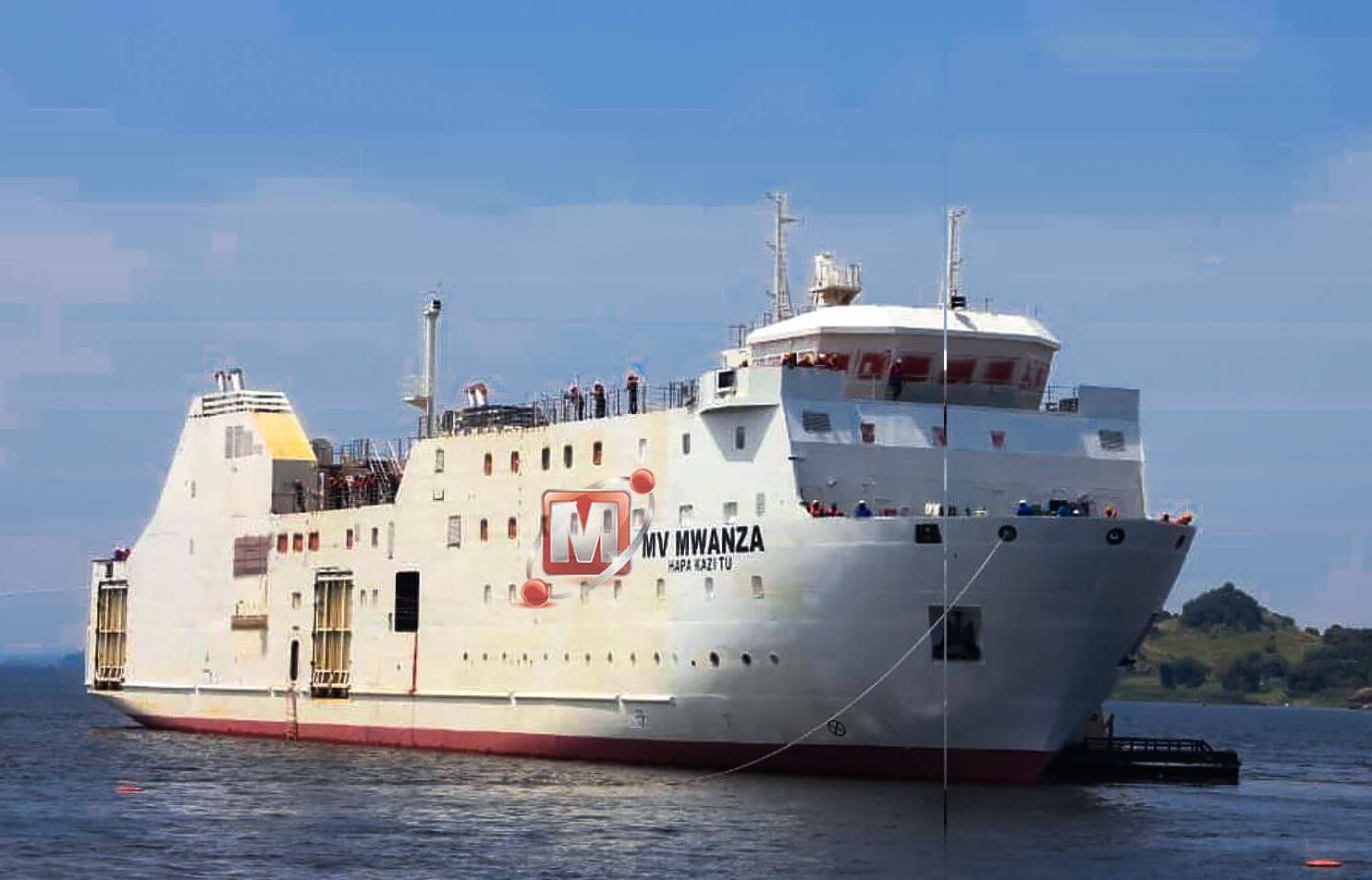On Sunday (February 12), Tanzania floated East Africa’s largest-ever domestically manufactured freshwater passenger and cargo ship, the MV Mwanza Hapa Kazi Tu, on Lake Victoria.
The ship, launched at the Mwanza South Port, can carry 1,200 passengers, 400 tons of cargo, 20 small vehicles and three trucks. It is currently 82% complete.
“Up to this point of float-out, we can say the ship is complete, and the remaining 18% is just minor installations that will be done in less than four months,” said Eric Hamissi, chief executive officer of Tanzania’s Marine Services Company Limited.
Hamissi explained that the next phase includes finishing internal aesthetics, including paintwork, fixing air conditioners, beds, and toilets and installing navigation equipment.
The ship’s construction began in January 2019, led by two South Korean companies, Gas Entec and KangNam Corporation. The 92.6 metre-long, 17-metre wide, and 20-metre-high vessel will cost the taxpayers over Tsh100 billion (US$43 million).
“Until now, the contractor has been paid more than 93.8 billion by the government; and when he completes the work, the remaining amount will be paid,” said Hamissi.
Upon completion, the ship will weigh 3,500 tons, an increase of 500 tons from the current 3,000 tons.
The MV Mwanza’s design includes an elevator section for people with disabilities, a clinic to provide health services, a disco and facilities for a music band to entertain passengers.
The ship will ply Lake Victoria, providing a critical transport and trade network between Jinja and Portbell in Uganda, Kisumu in Kenya, and Mwanza, Bukoba, Kemondo, and Musoma in Tanzania.
The vessel will have a VVIP section for national leaders and regular VIP facilities, including a first-class section with a capacity for 60 people, business class for 100 people, and second-class for 200 people.
“The last will be the economy class which will be carrying 834 passengers, and in this class, passengers will enjoy a modern ambience with maximum relaxation enabling them to tour comfortably,” said Hamissi.
The government expects the ship to stimulate economic growth, especially after the 2026 railway project (SGR) completion from Dar es Salaam to Mwanza.
The ship will help “open new markets inside and outside the country by starting new trips that will help facilitate commercial, business, tourism and private trips,” Tanzania’s deputy minister for works and transport, Atupele Mwakibete, said.
The country is also renovating the MV Umoja, a cargo vessel, the MT Nyangumi, for carrying petroleum products, and the MT Ukerewe.
Made in Kenya by Kenyans
Kenya officially relaunched the refurbished MV Uhuru 1 in May 2021 after the project stalled for over 15 years.
Since it resumed operations, the MV Uhuru, with a 1,260-ton capacity, has transported over 50 million litres of petroleum products.
The success of the Uhuru saw the government order a new vessel, MV Uhuru II, from Kenya Shipyard Limited (KSL) in Kisumu.
The 1,800-tonne, 100-meter vessel, with an estimated capacity of 2 million litres of crude oil per trip, is the first ship to be made in Kenya by Kenyans. Dutch firm Damen Damen Construction Company, which has shipyards in South Africa and Egypt, has provided consultancy services during the ship’s construction.
The Sh2.4 billion (US$ 19.2 million) MV Uhuru II vessel was floated in August 2022, expected to start operations in May 2023.
KSL has received six new orders for the construction of ships from Tanzania and Uganda and another 11 from local firms to construct vessels.
Uganda
Uganda also shipped its maiden fuel cargo from the Port of Kisumu using a newly-launched tanker, Kabaka Mutebi 11, in December 2022.
The 4.5 million litres of fuel ferried aboard that ship marked the revival of a water transport corridor between Kenya and Uganda. The MV Mwanza will further boost burgeoning trade across Africa’s great lakes.
“With the vessel’s full utilisation, fuel prices will reduce, resulting in fair commodity prices in the country,” Geoffrey Balamaga, assistant commissioner of Field Services, told Uganda’s Independent in an interview.
A cubic meter of fuel (1,000 litres) currently costs US$40 to transport to Uganda by road, compared to a maximum of US$25 by ship.
In 2021, Uganda’s government also commissioned the transportation of petroleum products aboard the MV Kaawa from Mwanza, Tanzania, to Port Bell in Kampala. Uganda’s Mahathi Infra Uganda Ltd is busy constructing three more vessels.
In 2019, the East African Community, at a joint ministerial meeting on strategy for Lake Victoria integrated transport programme, shared that Lake Victoria’s transport infrastructure has the potential of generating US$60 billion worth of trade annually but currently only realises around USD$6 billion for the three countries combined.
bird story agency
On February 12, Tanzania launched East Africa’s largest domestically manufactured freshwater ship, MV Mwanza Hapa Kazi Tu, on Lake Victoria. The vessel is 82% complete and can carry 1,200 passengers, 400 tons of cargo, 20 small vehicles, and three trucks. Construction began in January 2019, led by South Korean companies Gas Entec and KangNam Corporation, with a total cost exceeding Tsh100 billion (US$43 million). The ship will provide critical transport and trade links between Tanzania, Uganda, and Kenya.
The MV Mwanza features facilities such as an elevator for the disabled, a clinic, a disco, and sections for VVIPs, VIPs, and various passenger classes. It is expected to stimulate economic growth by opening new markets and facilitating commercial, business, tourism, and private trips.
In addition, Kenya relaunched the refurbished MV Uhuru 1 in 2021 and floated a new vessel, MV Uhuru II, in August 2022. Uganda also shipped its first fuel cargo using the newly-launched tanker Kabaka Mutebi 11 in December 2022, marking the revival of a water transport corridor between Kenya and Uganda. Lake Victoria's transport infrastructure has the potential to significantly boost trade in the region, which is currently underutilized.






